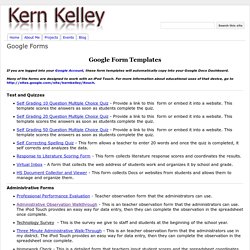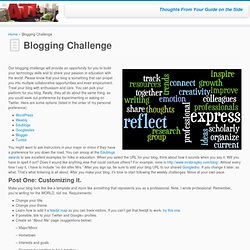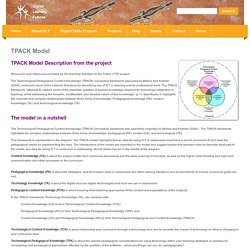

Maps & Earth: Hidden Treasures - Google Slides. G(Math) Midwest Google Summit Resources. Maps Gallery. Artifact Creation. Forms - Kern Kelley. Google Form Templates If you are logged into your Google Account, these form templates will automatically copy into your Google Docs Dashboard.

Many of the forms are designed to work with an iPod Touch. For more information about educational uses of that device, go to Test and Quizzes Self Grading 10 Question Multiple Choice Quiz - Provide a link to this form or embed it into a website. Administrative Forms Professional Performance Evaluation - Teacher observation form that the administrators can use. Miscellaneous QR Code Generator - Creates QR Codes from URL's collected in a from.Science Fair Judging Form - This is the scoring form used in a middle school science fair.Story Board - Used by student groups to write and produce a video project. EdTech Learning Theory Reflections.
Blogging Challenge. Our blogging challenge will provide an opportunity for you to build your technology skills and to share your passion in education with the world.

Please know that your blog is something that can propel you into multiple collaborative opportunities and even employment. Treat your blog with enthusiasm and care. You can pick your platform for you blog. Really, they all do about the same thing, so you could seek out preference by experimenting or asking on Twitter. Here are some options (listed in the order of my personal preference): You might want to ask instructors in your major or minor if they have a preference for you down the road. Post One: Customizing it. Make your blog look like like a template and more like something that represents you as a professional. Change your titleChange your themeLearn how to add it a feedjit map so you can track visitors. . – Major/Minor – Hometown. Jessica Brogley. The SAMR (Sam-err) model is an excellent model for teachers to reference when designing lessons.

Teachers can evaluate how they are integrating technology in a way that guides them towards wise decision-making. The SAMR model focuses on transforming learning, not integrating the tools. blog/archives/3980 In edtech classes you’ll be flooded with oodles of gadgets and digital resources, but remember that the technology can not drive decisions (planning or learning). The quest of knowledge is what drives decisions. Ruben Puentedura developed the SAMR model. In summary the layers look like this: Substitution: You are simply replacing an older technology, but you are doing the same activity, essentially. Example: You take your paper study guides and publish them online for kids to fill out on a computer. Augmentation: You are replacing an older technology with the idea of enhancing the original assignment.
When you plan out lessons, be sure you’re thinking through the SAMR model. Constructivism as a Paradigm for Teaching and Learning. What is constructivism?

How does this theory differ from traditional ideas about teaching and learning? What does constructivism have to do with my classroom? Expert interview What is the history of constructivism, and how has it changed over time? What are some critical perspectives? What are the benefits of constructivism? What is constructivism? Constructivism is basically a theory -- based on observation and scientific study -- about how people learn.
In the classroom, the constructivist view of learning can point towards a number of different teaching practices. Constructivist teachers encourage students to constantly assess how the activity is helping them gain understanding. You might look at it as a spiral. For example: Groups of students in a science class are discussing a problem in physics. Contrary to criticisms by some (conservative/traditional) educators, constructivism does not dismiss the active role of the teacher or the value of expert knowledge. Digital Learning Futures. TPACK Model Description from the project Resources and references provided by the teaching Teachers to the Future (TTF) project.

The Technological Pedagogical Content Knowledge (TPACK) conceptual framework espoused by Mishra and Koehler (2006), underpins much of the national directions for describing use of ICT in learning and for profesisonal work. The TPACK framework “attempts to capture some of the essential qualities of teacher knowledge required for technology integration in teaching, while addressing the complex, multifaceted, and situated nature of this knowledge” (p.1). Specifically it: highlights the nuanced and complex relationships between three forms of knowledge: Pedagogical knowledge (PK), content knowledge (TK); and technological knowledge (TK). The model in a nutshell The Technological Pedagogical Content Knowledge (TPACK) conceptual framework was described originally by Mishra and Koehler (2006).
This framework is represented in the diagram. The digitally literate learner: Tchng 2010. Education_leadership_technology.pdf.